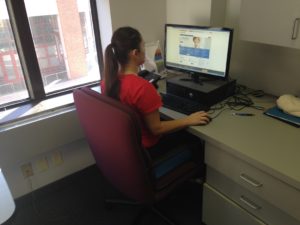Harbor Physical Therapy is doing an Injury Prevention and Screening Clinic at Charm City Run on June 27th at 10 AM – 12 PM. Looking forward to seeing you there!!!!
Are you a fall risk?
Falls are the number one cause of accidental death in adults over 65 years of age. Here are 3 questions you should ask yourself to determine if you are a fall risk:
1. Have you fallen in the past 6 months?
2. Are you afraid of falling?
3. Do you feel the need to use your arms to rise from chairs or hold onto objects to maintain your balance?
If you answered YES to any of these questions, it might indicate that you may be a fall risk. A quick screening test done by a physical therapist to determine if a patient is a fall risk is called the “Sit to Stand” test. It is used to categorize patients into high, moderate or low fall risk.
Here is the Sit to Stand test in a nutshell:
1. The patient is asked to sit in the middle of the chair with their feet flat on the floor and arms folded across their chest.
2. Come to a full stand and return to a complete sitting position.
3. Repeat as many times as they are able to in 30 seconds.
Results:
8 or less times in 30 seconds = High Risk
9 to 12 times in 30 seconds = Moderate Risk
13 or more times in 30 seconds = Low Risk
If you are in the moderate to high fall risk category, make an appointment with your local physical therapist to prevent future falls.
SEE no EVIL, HEAR no EVIL, FEEL no EVIL
The three components of balance comprise of the visual system (SEE), proprioceptive system (FEEL), and the vestibular system (HEAR – located in the inner ear). The brain integrates and processes all the information from these 3 systems to help us maintain our balance or sense of equilibrium. When you start to have problems with your balance, one or more of the above systems might be affected. Let us examine each of these systems briefly.
SEE no EVIL – Visual system
Receptors in the retina are called rods and cones. When struck by light, the receptors send impulses to the brain that provide visual feedback on how a person is oriented relative to other objects. This is how we know when we are upright or lying sideways.
HEAR no EVIL – Vestibular system
The vestibular system in each ear is made up of the utricle, saccule, and three semicircular canals. The utricle and saccule detect up, down, and side to side movements. The semicircular canals detect rotational movement. When the head rotates in the direction sensed by a particular canal, the receptors in that canal sends impulses to the brain about movement. When the vestibular organs on both sides of the head are functioning properly, they send symmetrical information to the brain.
FEEL no EVIL – Proprioceptive system
Proprioceptive sensory/mechanoreceptors from the skin, muscles, and joints are sensitive to stretch, pressure, and movements. With any movement of the body, the receptors respond by sending impulses to the brain which then interprets these movements. This is how even with your eyes closed you can tell if your elbow is straight or bent or which way your head is turned.
Defining Sciatica
Pain in the buttocks that radiates down the leg is referred to as sciatica. The most common cause of sciatica is irritation of the spinal nerves in or close to the spine. Sometimes the source of sciatic pain can be further down the leg in the buttocks. Before the sciatic nerve begins its path down the back of the leg, it runs under or through a deep pelvic muscle called the piriformis. When the piriformis squeezes or irritates the sciatic nerve, this can cause symptoms of sciatica. It has not been definitively proven why the piriformis sometimes starts to irritate the sciatic nerve. Most physicians feel it is from the muscle spasming and tightening to squeeze the sciatic nerve against the pelvic bone. It can also occur from a fall onto the buttocks that bruises the piriformis causing swelling and pressure against the sciatic nerve. As the muscle heals, scar tissue forms which is not as elastic as normal, healthy tissue. This can continue to put constant pressure on the sciatic nerve.
Tips on Staying Fit During the Winter
Winter weather is upon us! Even though temperatures are dropping, there are many options to continue exercising safely. If you spent the warmer months exercising outdoors, but continued making monthly membership ‘donations’ to your local fitness center, use this winter to redeem your money’s worth of classes and workouts! Gyms offer plenty of indoor cardio, conditioning, and strengthening exercise options. Most gyms also offer fitness classes if you like the group setting. If a gym membership is not your thing, there are also many exercise options online, TV on Demand, or on DVD. If you still plan to battle the elements and exercise outdoors through the winter months, be sure to make use of warm, protective clothing. Proper footwear, warm socks, hats, gloves, and layers are all important! Also, remember winter brings shorter hours of daylight so use reflective gear whenever necessary! Always remember safety first and consider alternatives to outdoor exercise when icy or extra cold outside!
What is a Trigger Point?
We have close to 400 muscles in the human body. Muscles can develop trigger points which can refer pain and cause dysfunction. Symptoms can range from intolerable agonizing pain caused by “active” trigger points, to painless restriction of movement and distortion of posture from “latent” trigger points.
There is not conclusive research on the definition of a trigger point. However, many characteristics have been observed for decades by researchers all over the world. There are many mechanisms by which we develop trigger points. Some of those mechanisms include poor posture, injury to a muscle, muscle overuse, and repetitive stress overload. Trigger points limit range-of-motion and cause muscle fatigue.
When pressed on, trigger points feel like “knots” or tight bands in the muscle, and are usually tender. Healthy muscles usually do not contain knots or tight bands and are not tender to pressure.
Good news!!! Physical Therapy diminishes trigger points. Physical Therapy addresses trigger points by identifying and treating the primary driver of the trigger point. This is done through trigger point release, massage, and posture re-education.
Herniated Disc- Definition and Symptoms
A herniated disc is a condition in which the tough outer wall of an intervertebral disc (a soft cushion that sits between each vertabrae of the spine) has been weakened. The herniation causes the cushion that sits between the vertebra to be pushed outside its normal position.
A herniated disc commonly occurs in the low back and sometimes in the neck. Very seldom do they occur in the mid-back due to the extra stability provided by the rib cage. In some cases, a herniated disc will press against the spinal nerves, causing pain, numbness, tingling, or muscle weakness.
Pain
Pressure on the nerve can cause abnormal sensations, commonly experienced as electric shock pains. Compression in the neck region causes pain down your arms and compression in the low back region causes pain down your legs.
Tingling & Numbness
You might experience sensations such as tingling, numbness, or pins and needles. These symptoms may be experienced in the same region as painful sensations.
Muscle Weakness
Because of the nerve irritation, signals from the brain may be interrupted causing muscle weakness. Nerve irritation can also be tested by examining reflexes or having your doctor perform an EMG test. An EMG test is a technique for evaluating and recording the electrical activity produced by skeletal muscles.
Bowel or Bladder Problems
These symptoms are important because it may be a sign of Cauda Equina syndrome, a possible condition resulting from a herniated disc. This is a medical emergency! See your doctor immediately if you have problems urinating, having bowel movements, or if you have numbness around your genitals.
If you experience any of these symptoms listed above, contact your physician or physical therapist to determine the appropriate course of treatment.
How to Achieve an Ergonomic Workstation
1. Adjust chair height so that your feet are flat on the floor.
Use footrest if you can’t achieve this.
2. Keep your wrist posture neutral.
3. Keep your monitor between 20 and 40 inches from your face.
4. Adjust monitor so that the center sits at eye level.
5. Place your keyboard so that your upper arms are perpendicular to the floor.
6. Chair is adjusted to keep body supported in an upright position.
7. Back rest is adjusted to fit the lumbar region of your spine.
8. Keep work within 16 inches of your body.
How ergonomic is our Harbor PT employee Liz?

How to Decrease Strain on Your Back While Driving
Sitting for a long period of time can put a strain on your back causing lower back pain. Listed below are some tips to reduce strain on your back while driving.
1. Avoid driving for more than 2 hours. Get out and walk around and stretch your legs.
2. Adjust your seat from time to time.
3. Use a lumbar support or seat cushion.
4. Short drivers can purchase a pedal extension to improve their sitting posture.
5. Use cruise control.
6. Move your seat up to avoid slouching.
7. Heat your seat to provide warmth to your muscles.
8. Ice your back when you get to your destination.

